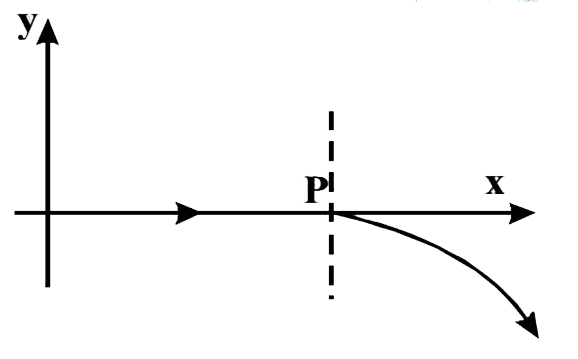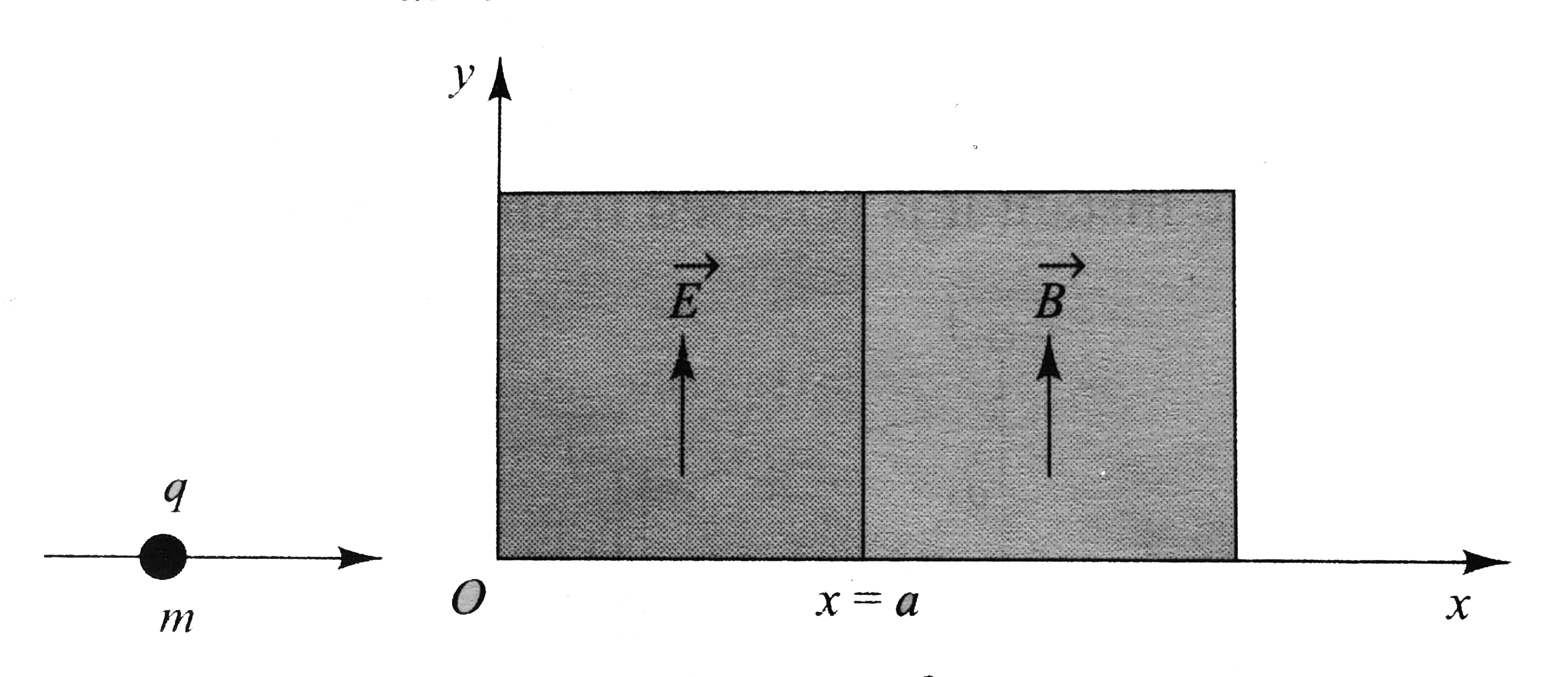For a positively charged particle moving in a x−y plane initially along the x-axis , there is a sudden change in its path due to the presence of electric and//or magnetic fields beyond p . The curved path is shown in the x−yplane and is found to be non - circular. Which one of the following combinations is possible ?

→E=0,→B=bˆi+cˆk
→E=aˆi,→B=cˆk+aˆi
→E=0,→B=cˆj+bˆk
→E=aˆi,→B=cˆk+bˆj
The correct Answer is:b
The velocity at P is in the x direction (given). Let →V=mˆi.
After P, the positively charged particle gets deflected in the
x-y plane toward-y direction and the path is non-circular.
Now, →F=q(→v×→B)
=q[mˆi×(cˆk+aˆi)] [for option (b)]
=q[mcˆi׈k+maˆi׈i]=mcq(−ˆj)
Since in option (b) electric field is present, i.e., →E=aˆi,
therefore, it will also exert a force in the +x direction. The
net result of the two forces will be a non-circular path.
Only option (b) fits for the above logic. For other options,
we get some other results.
Topper's Solved these Questions
- MAGNETIC FIELD AND MAGNETIC FORCESBOOK - CENGAGE PHYSICS ENGLISHCHAPTER - MAGNETIC FIELD AND MAGNETIC FORCESEXERCISE - Archives Multiple Correct
9 Videos
- MAGNETIC FIELD AND MAGNETIC FORCESBOOK - CENGAGE PHYSICS ENGLISHCHAPTER - MAGNETIC FIELD AND MAGNETIC FORCESEXERCISE - Archives Comprehension
2 Videos
- MAGNETIC FIELD AND MAGNETIC FORCESBOOK - CENGAGE PHYSICS ENGLISHCHAPTER - MAGNETIC FIELD AND MAGNETIC FORCESEXERCISE - Archives True /false
4 Videos
- INDUCTANCEBOOK - CENGAGE PHYSICS ENGLISHCHAPTER - INDUCTANCEEXERCISE - Concept Based
8 Videos
- MISCELLANEOUS VOLUME 3BOOK - CENGAGE PHYSICS ENGLISHCHAPTER - MISCELLANEOUS VOLUME 3EXERCISE - True and False
3 Videos
Similar Questions
Position vector of a particle moving in x−y plane at time t is r=a(1−cosωt)ˆi+asinωtˆj. The path of the particle is
View SolutionA positively charged particle moving along x-axis with a certain velocity enters a uniform electric field directed along positive y-axis. Its
View Solutionx and y co-ordinates of a particle moving in x−y plane at some instant of time are x=2t and y=4t.Here x and y are in metre and t in second. Then
The path of the particle is a…….
View SolutionA charged particle moves along a circle under the action of possible constant electric and magnetic fields. Which of the following are possible?
View SolutionA particle of mass m and positive charge q is projected with a speed of v0 in y–direction in the presence of electric and magnetic field are in x–direction. Find the instant of time at which the speed of particle becomes double the initial speed.
View SolutionAn electric dipole is placed at origin in the xy plane with its orientation along the positive x-axis. The direction is electric field .
View SolutionA point mass is moving in the x-y plane. Its acceleration is a constant vector perpendicular to the x-axis. Which of the following do/does not charge with time ?
View SolutionA particle of mass m carrying a positive charge q moves simple harmonically along the x-axis under the action of a varying electric field E directed along the x-axis. The motion of the particle is confined between x=0 and x=2l. The angular frequency of the motion is ω. Then which of the following is correct ?
View SolutionA moving charged particle q travelling along the positive X-axis enters a uniform magnetic field B. When will the force acting on q be maximum?
View SolutionA positively charged particle, having charge q, is accelerated by a potential difference V. This particle moving along the x-axis enters a region where an electric field E exists. The direction of the electric field is along positive y-axis. The electric field exists in the region bounded by the lines x=0andx=a. Beyond the line x=a (i.e., in the region x>a), there exists a magnetic field of strength B, directed along the positive y-axis. Find

a. at which point does the particle meet the line x=a.
b. the pitch of the helix formed after the particle enters the region x≥a. (Mass of the particle is m.)
View Solution
